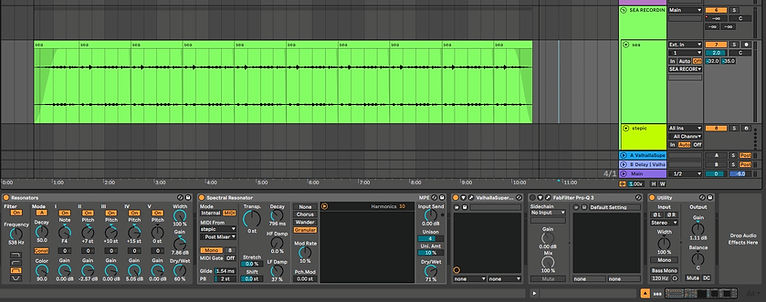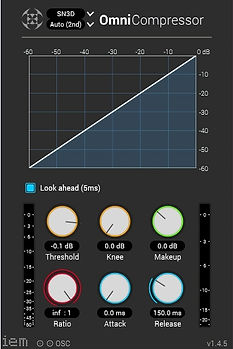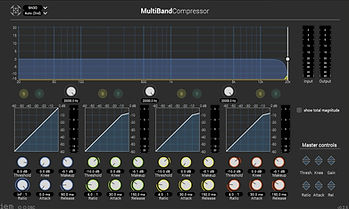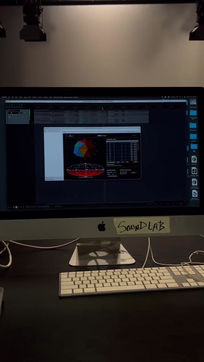About
The project employs generative compositional techniques to build ambient textures, minimalism structures, electronic processing and rhythms within an immersive ambisonics soundscape. Each composition originates from a generative motif, explored through diverse instrumentation, field recordings, and modulation to establish its distinctive sonic identity. The album enables seamless track transitions, allowing infinite playback loops as a kind of meditation or simply the background to be ignored.
The production aims to convey meditative tranquility which express my personality. Through careful sound-selections and ambisonics spatialization, the works construct environments that mirror my own characteristic and also perspective on interpersonal relationships.
Serving as an auditory memoir, this project abstracts 4 years of Hong Kong life into a non-locational mental journey. It is proposed as audible fluid scenes shaped by emotional changes rather than physical coordinates. The title where it takes me to... also indicates that attribute. Through this album, audience will experience the journey alongside with me, resonance to my feelings and perhaps arouse their own minds to take them somewhere else.
Keywords: Ambient, Generative, Minimalism, Electronic, Ambisonics.
Composition
"山重水复疑无路,柳暗花明又一村"
As the first track, this piece represents the process of "diving into the unknown to seek inspiration". It is based on my apartment which is on 9F of a shabby building. Since there's no elevator, I have to go up through the dark, dirty, smelly stairs to finally get to my room. However, while repeating that automatic movements, I find myself being able to concentrate and think about my works and my life, which arouse my creativity me when I get home.
The whole track starts with a 6-bar piano motif. As it's repeating, the loop length changes to 5-bar, 4-bar... and back to 6-bar again. Meanwhile, the melody expands to different rhythms and registers. To a certain point when the additive process reaches its limit, all the elements are then slowly subtracted, ending up with the original motif. To have more variations, inspired by the "phasing effects" in minimalism music, another layer of piano melody is introduced. This melody layer is identical to the original one, but is offset a certain amount of duration (16th notes, 8th notes, etc.), creating more unexpected harmonies. Additionally, I automate the pitch to climb up 9 semitones smoothly throughout the track to indicates the theme.
To better support the concept, I add the recordings of me going upstairs, which are then heavily treated. For one layer I automate a low-pass filter and let it slowly open up as the track proceeds. It sounds abstract at first but as it reveals people would hear more details. The other layer is reverse and stretched, which sounds like whisper around my ear. This perfectly mimics the thoughts popping out in my head.
Last but not least, there are a rumble through the whole track and a pad to fill up the space. The rumble is inspired by the sound design of film Zone of Interest. It gives the sense of pressure and darkness, increases the feelings of stepping into the unknown, and sets the overall tone of this track.



“一石激起千层浪”
After the little exercise of 9F, I finally enter the place of creativity. It feels like a brand new world as soon as I walk through the door. Everything is peaceful and quiet and all I can hear is my own heartbeats... Following the heartbeats from the previous piece, this track is driven only by that heartbeat sound, which is the reason why it's named Ripples of Heartbeats.
To achieve that I create 6 return tracks with the heartbeats sent to them. Next I add different resonators and delays on different return tracks. Through that process, each of the return tracks is "powered" by the heartbeats but ends up having infinite possibilities (e.g. using the low-end of the heartbeats, adjusting the parameters on resonator, adding delay for different rhythm and here comes a bass pluck). Furthermore, the return tracks can also feed into one another to create even more complicated sounds, making it minimal in process, but maximum in outcome. I then layer a four-on-the-floor kick and a corresponding sub bass, which add a sense of techno.
In the second half of the track, a piano driven by the heartbeats is introduced. Instead of using resonator, I utilize CV tools to detect the "voltage changes" of the heartbeats and translate them into midi signals. The signals are then sent to Chord Generator to give random chords.
With the generative program done, the rest of the work is just to modulate and automate different parameters freely and let the heartbeats do its work.




“Behind the curtains, the sun never rises”
The journey continues as I am more relaxed. This piece demonstrates that I have fully embraced the "new world" that I sense from the last track. It is the time when I feel motivated and start producing something. I named this track Polar Night in MK because as I am being productive, the sense of time is most likely to be ignored. And since I am used to closing the curtains, I can't really tell whether it's day or night without looking at the clock. I enjoy this feeling where I devote myself into.
In this track I mainly explore the use of sequencers. With a variety of random functions and possibility adjustment, they can generate timeless sequences that will never be the same. For tonal elements, I use Stepic and some built-in sequencers in synthesizers to produce random midi notes. The sequences are set to different length as well as the notes. Additionally, I introduce more notes to the piano to create random chords and harmonies. Therefore, the piano sounds like an actual auto piano.
The process with the drums is fairly the same, but with Rhythmic Sequencers. Different drums sounds are stored in racks and then are spread evenly into the sequences. To give more groove and make them bouncier, I apply additional repeater and panner with random modulation on.
Finally, to make everything more dreamlike and ambient, I layer some pads and a recording of the sea at the bottom. The recording is resonated to be tonal, and then receives midi inputs from Stepic. In this way it gives texture to the piece. This indicates that as I am drowning in my creativity, my mind starts to take me somewhere else.




“星垂平野阔,月涌大江流”
From this track, the journey gets to a new stage where I'm no longer in the small world inside my apartment and my mind can now take me wherever I want. Here it takes me to a boundless grassland under the spectacular starry sky. Among the ultimate serene, I'm able to lie down on the grass and get enveloped by the universe.
Aiming to create that sense of peace and meditation, I choose to use only Chinese instruments as I find them perfect for painting ambience. However, unlike the traditional way of composition, they follow the method from the previous track: being driven by sequencers.
To mirror the image of the starry sky, there are six layers of Konghou(Chinese harp) in different sequence length, note possibilities and registers. Each layer follows its own rules and intertwine with one another, creating that scene of stars blinking. Additionally, there's a synth pad to fill in the high-end blinking sound.
For the texture of breeze and grass, I introduce a Xiao and a recording of the grassland. The Xiao is receiving midi inputs from Harmony Bloom, which is also a midi generator. Furthermore, I randomized the expressions of Xiao so that on each note being played, it will trigger a different skill of performing, giving that realistic woodwind sound. This greatly enhance the texture of the breeze. On the contrary, for the recording, I apply lots of reverbs and delays to make it less realistic and more dreamlike. Those delays perfectly bring out some details inside the recording.
The last set of elements is the string section. It is divided into 3 parts: the low bass, the mid chord and the high melody. Each of the parts is driven by Stepic. To increase the dynamics of the strings, I modulate the midi cc expression control and velocity control. In this way the strings mimic the wind slowly getting heavier and immerse everything.





“天与云与山与水,上下一白”
As a continuation of Stardust, these 2 tracks share a similar vibe of tranquility. The scene changes from a edgeless grassland to a silent lake. Snowflakes spread out through the entire scene and merge the background into a white canvas, while I'm the tiny dot in the center, as if floating in the air. The name "Kong" means emptiness in Chinese and also represents Hong Kong, indicating my inner peace among the city.
Compared to other pieces, this track has less uncertainty and most of the elements are designed and placed carefully. The genres of Hip Hop and Electronics are combined for swinging grooves while synthesizers and traditional instruments complete one another.
The foundations of the piece are a number of synth pads and textures. The textures include real recordings like water drips and synthesized sounds. Most of them are drown with reverbs and delays, giving that sense of everything being merged by the snow and fog.
To paint audible snowflakes onto the canvas, I introduce some synth plucks and Guzheng that mirror the snow floating around. They also come with lots of delays and are spread throughout the whole tracks as ear candies.
Additionally, in the second half of the track, there's a guitar that is relatively close in space and sounds cleaner. This represents me myself in the whole scene created but also my own consciousness among my inner space. It also gives the audience something to focus on in that "Kong" so that they won't get "snow blind".
For the drums I choose to use typical Hip-Hop patterns and some traditional Chinese percussions. To merge them with the above scene created, I treat them with reverbs and delays as well and leave more space between them when arranging.
Finally, to enhance the scene even more and fill the space and spectrum, I simply compose some strings sections and vocal chops.




"Can you hear the world singing"
Serving as another turning point, I start wandering slowly back to the reality in this track. Yet, despite of staying in the loop of ordinary mundane life, I am able to hear everything different. The sounds of the surroundings are no longer the way they were, but musical elements that I can compose. The sound of leaves can be a drone for meditation, the footsteps of people can be percussions of dance beats... It's all about the way I "hear" it.
To support that concept, most of the sounds in this piece are from field recordings that I record. The main technique that I use for sound design for these recordings is to heavily resonate certain frequencies (e.g. 440Hz which is A3 in key). In this way the sound will have both the note in tune and the texture of the actual recording, which makes the sound a lot more interesting. I adjust the envelope (ADSR) of the sound to shape it into different timbres like pads, plucks, kicks, snares and so on. All kinds of effects are then applied accordingly, like delays, reverbs, chorus, distortions etc. Last but not least, they receive midi inputs from different midi generators to keep everything flowing.
The process with the drums is relatively easier. I simply take the frequencies that I want and enhance them while adjusting the ADSR. The composition contains a Hip Hop section and the (dub) techno section.
In between sections, there are also transitions and FXs elements, they are also chops from recordings like noise of construction sites, clicks on the bars and so on. Towards the very end, all the "unrealistic" sounds suddenly stop, leaving only the erhu section that I record from several places and combine together. This indicates my return to the reality, reminding that the journey is about to end.




"Some kind of peace"
As the ending of the album, everything land softly back to where they started: the small apartment. The relaxing, yet somehow melancholy piano gently massages my mind. My thoughts become clearer than ever, which leads me to some self-reflections.
To respond to 9F, this piece also uses phasing piano as its main feature. Similarly, I compose an 8-bar motif, which is then divided to 5 layers by registers. Each of the layers is offset by a 1/4 note to each other. They keep playing until they match once again. That is all the track is about: peaceful piano melody, like a lullaby.
When the piece proceeds slowly towards the end, the low rumble from 9F comes back again. At the very end when the lullaby is over, I record myself closing the piano, opening the door and leaving yet there isn't the sound of door closing. Instead, it goes all the way back to 9F and loop the album once again. Perhaps in the end I'm not leaving, but to step into a new start.


mIXING
Since this album is meant to be an ambisonics project, I render all the stems from each track and start mixing them in Reaper in ambisonics. The mixing processing mainly features IEM Plugin Suite, which contains a lot of handy plugins for encoding, decoding and ambisonics mixing.
The most efficient way is to set up a template first. I create an ambisonics bus, routing to the binaural decoder track so that I can mix with my headphones.
From my point of view, the steps for mixing in ambisonics is fairly minimal as well: it's all about how to fully utilize the whole space and place all the elements using the stereo encoder. Throughout the whole process, I usually place stems based on frequency, timbre and usage. For lower stems like basses and kicks, they stay at the bottom with less stereo width to avoid phasing issues. For pads and ambience, I tend to spread them out evenly in the middle range of the sphere to have them fill in as much space as possible. For higher melodies and drums especially percussive elements, I would like to modulate or automate their locations so that they could flow in the sphere, and perhaps creating interesting combinations or harmonies.
Most of the time I won't add too much EQs or compressions to the tracks as they are more or less done on the sound design stage and the stereo rough mix. Another reason is that the EQ and compressors in IEM are not as robust as I expect in terms of controlling frequencies and dynamics. Therefore I simply cut the unwanted lows and boost some highs for most of the stems. However, for tricky tasks like stop bass and kick from crashing into each other, the directional compressor appears to be quite convenient to "dig a hole in bass for kick". Still, it is a pity that it doesn't have a side-chain function.
To merge everything better in space, I introduce a return reverb where all the stems are sent to. The amount being sent defines whether something is closer or farther. This prevent a sound to be out of place if that sound has been drowned with reverb in the sound design stage.
Another challenge is to create smooth transitions between each track for a seamless playback while continuate the journey. From 9F to Ripples of Heartbeats there are heartbeats in between. At the end of Ripples of Heartbeats I compose another piano section to reach Polar Night in MK. The next two tracks are mainly connected by the field recordings of nature. At the end of Can You Hear It, I record myself playing the motif of Lullaby on a piano. And the rumble in Lullaby leads it back to 9F again.
After I'm pleased with the mix on headphones, I test it on a 14 speakers system and adjust the mix accordingly to ensure the spatial placements and effects are what I expect.








mastering

On the last stage of the project, all I do is trying my best to make the tracks sounds as loud as possible without destroying the dynamics. However, as I mentioned that the IEM compressors aren't very powerful, and I'm not very professional in using them either, I have to stack several compressors together to get the sound that I want. Yet the loudness is still rather limited.
For the first compressor, I use small ratio and relatively fast attack and release to control the dynamics. Next, I imitate the SSL Comp style mastering compression to glue everything together and make them sound more as a whole. I then add an EQ to boost some of the low-end and mid-highs, following by another soft mastering compression. At the end there are 3 limiters sitting at the bottom (I have no idea why it keeps having transient sneaking out from the limiters).













